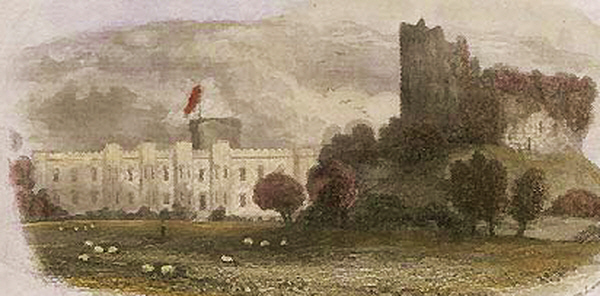Home > Historical Heritage Tours > Kingdom of the Dragon and Lion > < Day 7
We begin our last day of the tour by a visit to the largest castle in Wales and one considered to have the finest regular concentric fortifications in the British Isles. Caerphilly Castle was built between 1268 and 1271 by the Anglo Norman Lord Gilbert de Clare and at the time the Welsh were in rebellion against rule of the Anglo Norman crown. The castle provided a defensive base from which this rebellion could be controlled as well as an administrative centre. However in 1270 the Welsh rebels attacked the uncompleted castle and set it alight and this gave the impetus to further strengthen 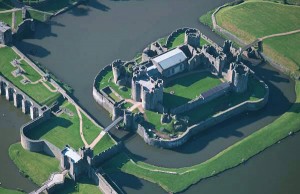 it’s outer defenses by a series of moats and walls, which stretch over a 32 acre area in the centre of Caerphilly. Throughout the late 13th century and early 14th century the castle continued to be the focus of attacks by the Welsh rebels and although the town was destroyed during an attack, the castle’s formidable defenses remained unbreached. By the end of the medieval period extensive conflict largely ceased and the castle gradually fell into a state of disrepair, although its defenses were further augmented during the time of English civil war. The castle was acquired by the third Marquis of Bute during Victorian times who undertook a full restoration. Thereafter three generations of Marquesses recorded the details of the castle, cleared structures built against its walls as leases ended and eventually undertook painstaking analysis and restoration of the fallen masonry to restore the Castle’s original form.
it’s outer defenses by a series of moats and walls, which stretch over a 32 acre area in the centre of Caerphilly. Throughout the late 13th century and early 14th century the castle continued to be the focus of attacks by the Welsh rebels and although the town was destroyed during an attack, the castle’s formidable defenses remained unbreached. By the end of the medieval period extensive conflict largely ceased and the castle gradually fell into a state of disrepair, although its defenses were further augmented during the time of English civil war. The castle was acquired by the third Marquis of Bute during Victorian times who undertook a full restoration. Thereafter three generations of Marquesses recorded the details of the castle, cleared structures built against its walls as leases ended and eventually undertook painstaking analysis and restoration of the fallen masonry to restore the Castle’s original form.
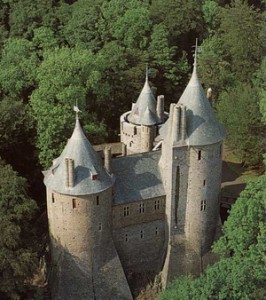 From Caerphilly we make our way southwards the finest example of of Medieval revival architecture in Wales, Castell Coch. Situated in an elevated position on a wooded hillside, this unique castle provides a picturesque quality to the valley by it’s spired towers which protrude high above the surrounding treeline, giving it the appearance of an archetypal fairytale castle. This impression is not misplaced to visitors approaching the entrance who can’t help be impressed by the sheer baronial grandeur of the buildings frontage as they cross over the working drawbridge. But these impressions are nothing compared to the visual splendour of the interior with it’s vibrantly coloured and highly detailed decoration and furnishings which comprise some finest Victorian medieval design seen anywhere. Castell Coch is both the vision and triumph of the architect William Burges who was given the task of creating a Medieval styled retreat for John Patrick Crichton-Stuart, the 3rd marquess of Bute, similar in style to his other castle residence at Cardiff. In this task Bugess excelled his clients expectations, producing one
From Caerphilly we make our way southwards the finest example of of Medieval revival architecture in Wales, Castell Coch. Situated in an elevated position on a wooded hillside, this unique castle provides a picturesque quality to the valley by it’s spired towers which protrude high above the surrounding treeline, giving it the appearance of an archetypal fairytale castle. This impression is not misplaced to visitors approaching the entrance who can’t help be impressed by the sheer baronial grandeur of the buildings frontage as they cross over the working drawbridge. But these impressions are nothing compared to the visual splendour of the interior with it’s vibrantly coloured and highly detailed decoration and furnishings which comprise some finest Victorian medieval design seen anywhere. Castell Coch is both the vision and triumph of the architect William Burges who was given the task of creating a Medieval styled retreat for John Patrick Crichton-Stuart, the 3rd marquess of Bute, similar in style to his other castle residence at Cardiff. In this task Bugess excelled his clients expectations, producing one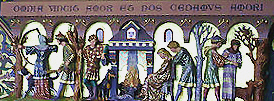 of the best examples of Medieval Revival Gothic architecture and decoration in the Country. The site of the castle comprised the remains of the 13th century Red Castle but the Victorians were not known for their sensitivity to fundamentally altering historic buildings in order to recreate a stylized historical look and in this Castell Coch was no exception as the castle was completely rebuilt into an entirely different form. Work began in 1875 and continued until 1891 to become the final triumph for the architect who created it and which we all can continue to marvel at today. We promise you will be truly amazed at the level of detailing within this Victorian Castle, the most memorable being a superb fireplace by Thomas Nicholls depicting the “Three Fates”, spinning, measuring and cutting the thread of life. An octagonal chamber with a spectacularly decorated rib-vaulted roof, modeled on one designed by Viollet-Le-Duc at Councy and incorporating painted butterflies and birds of sunny plume in gilded trellis work.
of the best examples of Medieval Revival Gothic architecture and decoration in the Country. The site of the castle comprised the remains of the 13th century Red Castle but the Victorians were not known for their sensitivity to fundamentally altering historic buildings in order to recreate a stylized historical look and in this Castell Coch was no exception as the castle was completely rebuilt into an entirely different form. Work began in 1875 and continued until 1891 to become the final triumph for the architect who created it and which we all can continue to marvel at today. We promise you will be truly amazed at the level of detailing within this Victorian Castle, the most memorable being a superb fireplace by Thomas Nicholls depicting the “Three Fates”, spinning, measuring and cutting the thread of life. An octagonal chamber with a spectacularly decorated rib-vaulted roof, modeled on one designed by Viollet-Le-Duc at Councy and incorporating painted butterflies and birds of sunny plume in gilded trellis work.
From Castell Coch we make the final leg of the journey to the capital city of Wales.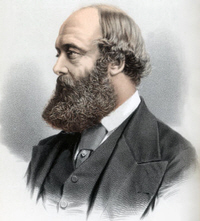 Situated on the River Taff close to the mouth of the river with the Severn Estuary, Cardiff developed as a commercial port as well as being the principle administrative and educational centre for Wales, with the main shipping good being coal on which the wealth of the Country depended during the 19th and early twentieth centuries. During this time many landowners became extremely prosperous if coal mines were
Situated on the River Taff close to the mouth of the river with the Severn Estuary, Cardiff developed as a commercial port as well as being the principle administrative and educational centre for Wales, with the main shipping good being coal on which the wealth of the Country depended during the 19th and early twentieth centuries. During this time many landowners became extremely prosperous if coal mines were 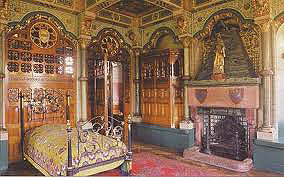 developed on their estates and one such man was the Third Marquis of Bute, who amassed a considerable fortune and indulged his taste in Medieval Gothic by commissioning a range of number of redevelopment projects, Caephilly Castle and Castell Coch being two such schemes. The grandest and arguably the finest of these was the complete reconstruction of Cardiff Castle in the centre of the city to become his main residence. Built on the foundations of the earlier Norman Castle and designed by the architect William Burges, who would later go onto to work on Castell Coch in a similar manner. The inside of the new castle residence at Cardiff is no less impressive in the sheer lavishness of the interior decoration and attention to the smallest of architectural detailing. Such is the level of decoration that
developed on their estates and one such man was the Third Marquis of Bute, who amassed a considerable fortune and indulged his taste in Medieval Gothic by commissioning a range of number of redevelopment projects, Caephilly Castle and Castell Coch being two such schemes. The grandest and arguably the finest of these was the complete reconstruction of Cardiff Castle in the centre of the city to become his main residence. Built on the foundations of the earlier Norman Castle and designed by the architect William Burges, who would later go onto to work on Castell Coch in a similar manner. The inside of the new castle residence at Cardiff is no less impressive in the sheer lavishness of the interior decoration and attention to the smallest of architectural detailing. Such is the level of decoration that 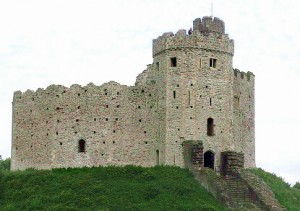 the inner halls of the castle are referred to as “The Palace” in which highly decorative and colourful murals adorn the walls, depicting animals and mythological figures. Where the are the intricately and detailed sculptures set within fireplaces and a stunning vaulted stone ceiling decorated in gold leave. Everywhere you look there is something to see which captures
the inner halls of the castle are referred to as “The Palace” in which highly decorative and colourful murals adorn the walls, depicting animals and mythological figures. Where the are the intricately and detailed sculptures set within fireplaces and a stunning vaulted stone ceiling decorated in gold leave. Everywhere you look there is something to see which captures  the eye and the imagination and at times the building appears more like a modern movie set than an actual residence or castle. Those interested in medieval history will be pleased to know that not everything of the early Norman structure was overwhelmed by reconstruction as the original octagonal keep remains in the centre of the complex. It is within this central square guarded by the castle walls that we will complete our journey along the Welsh Border lands and from where the coach will afterwards transport us to the hotel for the final night in Wales.
the eye and the imagination and at times the building appears more like a modern movie set than an actual residence or castle. Those interested in medieval history will be pleased to know that not everything of the early Norman structure was overwhelmed by reconstruction as the original octagonal keep remains in the centre of the complex. It is within this central square guarded by the castle walls that we will complete our journey along the Welsh Border lands and from where the coach will afterwards transport us to the hotel for the final night in Wales.
Although our Welsh Border Tour is completed in the Welsh capital city of Cardiff, subject to demand, Old School Tours offer an additional extra day touring the English city of Bath in the nearby county of Avon.




